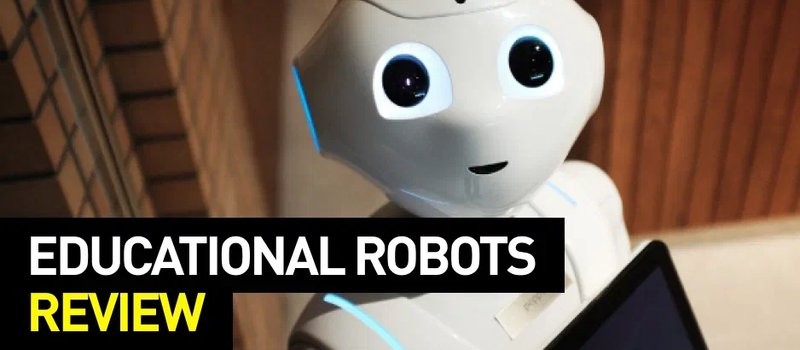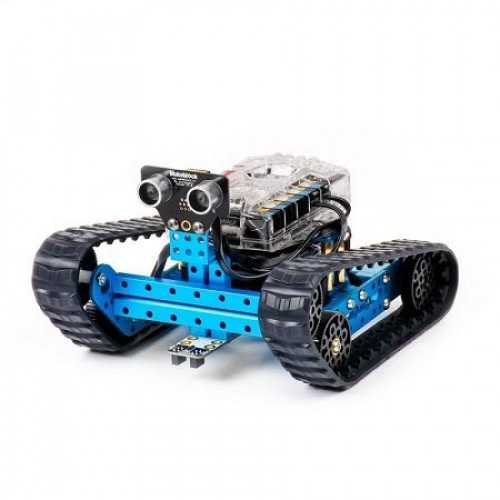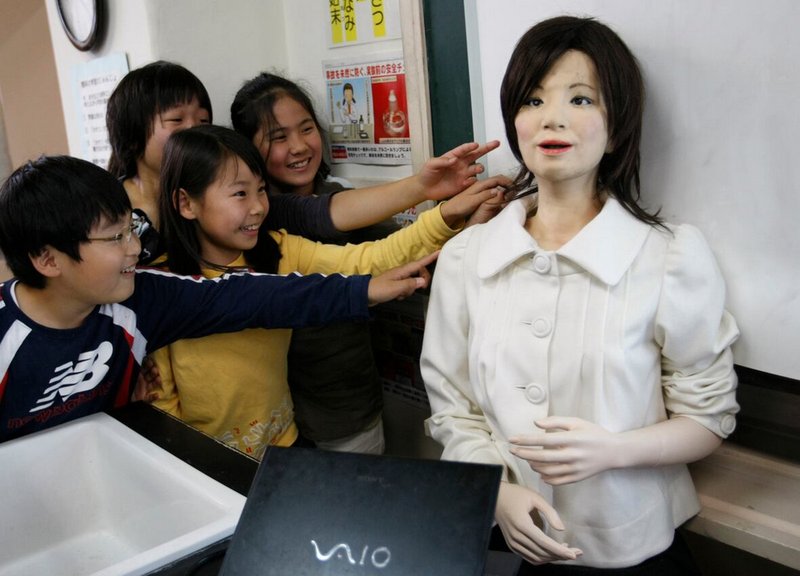
It becomes evident that modern education is closely associated with high technologies and robotization. Many schools are equipped with electronic whiteboards, while robotic systems for studying programming and engineering are employed at universities. So in this article, we will talk about the application of robotics in the field of education.
This market is constantly evolving: there appear many interesting developments from startups and large companies. The process has embraced all developed countries: not only the USA and Western Europe but also China.

Credit: robo-hunter.com
The educational branch related to the use of robots is called STEM, which means Science, Technology, Engineering and Mathematics. Read on to learn more.
There are a great many producers in the automated learning systems market, so let’s have a look at the most prominent ones.
As expected, primary education generally makes use of playing systems, which allow children to master the basics of high technology in an interesting way.

Lego Mindstorms
One of the largest manufacturers in this sphere is the famous LEGO company. They produce educational constructors which help children learn the basics of engineering. And with the WeDo 2.0 kit, pupils can even get some basic skills of programming, design, and scientific activities.

Credit: amazon.com

Makeblock mBot Ranger Robot Kit
Makeblock is a Chinese robot manufacturer that created mBot. This device is meant to teach children logical thinking and give them basic engineering skills. In a playful way, the child will master the basics of programming, learn to analyze and solve the assigned tasks.

ROBOTIS DARwIn-MINI
The Robotis company offers whole play sets in the form of robots that also teach children programming. These toys have built-in microcircuits that can be reprogrammed so the device performs certain actions.
Robots designed for middle and high school are naturally more serious. They allow solving specific tasks while getting to learn the intricacies of robotics and programming.

uArm can be “taught” to pick up objects and move them to a certain place.
The Chinese company uFactory is known not only for its high-performance xArm series of robotic arms — it also offers a solution for training called uArm Swift Pro. It is, too, a robotic arm that can be “taught” to perform various actions.

Students learn the basics of robotics by programming the device to perform this or that task. They can even create a conveyor for the full automation of processes.


Hanwha HCR-3 collaborative robot
Hanwha specializes in the development and manufacture of collaborative robots — those are designed with an emphasis on the direct interaction of human and robot in the industrial environment. Such robots make it possible to use real production systems for educational purposes, program the robotic arm to perform the necessary actions and process materials.
Robots for universities represent professional equipment that will help in scientific and engineering activities, in the implementation of projects and academic work.
The largest manufacturers of such devices are Fanuc and Kuka.

The robotic cell is controlled remotely.
Kuka offers a specialized training cell called ready2_educate. The robotic arm is capable of performing a variety of actions: moving, gripping, etc. Programming is carried out through the control box, with a plethora of tasks to be assigned to the robot.

The LR Mate 200iD is a professional device used in both production and training.
The Fanuc LR Mate 200iD robot is designed to solve production tasks. It is a small automatic arm with a variety of end effectors. The device is useful for engineers to perform material handling operations.

Credit: fastcompany.com
The Russel robot helps autistic kids socialize.
Robotic technologies can be used to simplify the learning process for children with medical conditions. For example, the Russel robot is designed specifically to work with kids suffering from autism.

Credit: nytimes.com
VGo is equipped with a display, speakers, and camera to create the effect of being in the school.
If a child for some reason cannot attend classes, the VGo device will be of use. The robot is controlled from a home computer, moves between classrooms, transmits and receives an image. And thanks to the speakers, the student will be able to contact other children.

Credit: www.sfgate.com
The unusual appearance of the robot stirs up interest and makes learning more fun.
In South Korea, some schools are equipped with the Engkey robot. This device transmits the teacher's voice to the classroom. Thus, students and schoolchildren learn English with the help of a remote teacher.

Chinese startup Makeblock aims to help students build robots and learn how to write computer programs in a fun way as the trend of robotics in education is becoming global.

mBot V1.1-Pink
The Shenzhen-based company has created an open source platform that allows users to easily assemble various mechanical parts and electronic modules. The technology is currently used in over 300 schools across China. Electronic kits allow students to build and manipulate simple robots as well as write basic programs.

Makeblock mBot v1.1-Blue, a robot constructor that can be controlled via Bluetooth.
While other educational robotic kits like Lego Mindstorm cost over $300, Makeblock devices start at $95. One of their most popular products is the mBot kit, which raised over $285,000 through a Kickstarter crowdfunding campaign.

mBot is not an ordinary ready-made robot. It needs to be assembled and programmed.
Robotic kits work with mBlock, a program that allows users to easily control robot movements by combining commands.
The company first started making parts for robots back in 2013, but then switched to STEM educational kits.
Several elementary schools in Zhengzhou and Jiangsu province have entered into an agreement with Makeblock, which builds innovation centers and robotics laboratories at their base.

Credit: asia.nikkei.com
The students are programming the robot.
Makeblock Education is rather easy to use as there is no need to install any programs. It is possible to write code directly in the browser and share it with other community members.

Credit: hanwha-security.com
Hands-on session with Hanwha cameras.
Beikent University in Istanbul was founded as a non-profit organization by the Adem Çelik-Beykent Foundation in 1997. Since then, it has expanded to five campuses with 29,000 students. The institute trains in 72 basic areas, 69 undergraduate specialties, and more than 50 postgraduate programs.
Medical students at Beikent University are required to complete laboratory activities, including audiometry and advanced modeling. However, in an audiometric laboratory, only 3 out of 20 students can sit in a “quiet” room where hearing tests are performed.
About 450 Hanwha Techwin cameras were installed on several campuses of the university from October 2015 to August 2017. Particularly, 2 megapixel (SND-6084R) and 5 megapixel high definition cameras (XNO-8080R) in laboratories to support the teaching of medical students.

Credit: hanwha-security.com
All auditoriums of the university are equipped with cameras.
In the audiometric laboratory, Wisenet cameras placed inside the room allowed the other 17 students outside to observe what was happening during the hearing tests. For advanced imitation of real reception, cameras transmitted images and sounds from three simulation rooms to one room of observation, which allowed students to see the process on screens.
The university also installed Wisenet cameras and recorders to create a safe environment for students and teachers in all locations, including dorms, classrooms, medical school, and the Faculty of Dentistry on the Avalon campus.
Hanwha's robotics can be used to train operators and maintenance technicians in robotic manufacturing. In particular, the HCR series collaborative robots are used at the Korean Changwon Moonsung University to teach students how to work with robotics.

Credit: livemint.com
The robot looks like a real woman and helps a human teacher give classes.
High tech and artificial intelligence are making their way into classrooms in the form of humanoid robots, replacing living teachers. This is not a plot from some movie about a distant future, but a reality in Bangalore, India.
“Our robots teach about 300 students in grades 7–9 every day in five subjects. They interact with children and answer their questions,”
said Vignesh Rao, the chief designer of the Indian International School.
Although the five-foot robots, dressed in formal female suits, do not completely replace real educators, they help them with teaching and answering students' frequently asked questions.
“We’ve programmed interactive robots to answer the questions that students ask most often.”

Credit: yourstory.com
A similar experiment to introduce a robot assistant into the educational process was carried out in one of the rural schools in India in Maharashtra.
The private international boarding school has 25 students in each class. The institution is associated with the International Baccalaureate Institute in Geneva and operates on its own program recognized all over the world.
AI-powered robots teach biology, chemistry, geography, history, and physics. The Collaborative Learning Model (CLM) employs a team of teachers, students, and a robot. The teacher collaborates with the robot and sets the main points that it should cover.
Rao and his 17-man team designed and manufactured three robots using 3D printing. These machines imitate human-like gestures and can move and speak.

Credit: www.thetechedvocate.org
Robot teachers can look different: some make them look like people, others are very futuristic.
“It took our team almost two years to design and develop these machines with software, hardware and artificial intelligence, make them assistants, and enable the human teacher to stay more focused on children and not on the subject.”
The team consists of a number of specialists: programmers, content developers, graphic designers, and engineers who have created mobile robots weighing 45 kg each.
Although the team did not use any manufacturer to build robots, they sourced hardware and software components from the best players in the industry.

Credit: inspire-edu.tech
Thanks to modern devices, teaching can be remote.
“The students' reaction to the robot is positive and encouraging. They feel that collaboration between a human teacher and a robot improves learning. This allows the human teacher to focus on the child and personalize the process.”
Considered the first of its kind, the school plans to scale up the pilot project and release more robots for other classes and subjects.
“The goal of CLM is to make human teachers more creative in education. Robots will not replace their colleagues — they will work together with teachers as a tool and assistant to improve the learning process.”

Credit: cbc.ca
The Saya robot was a famous Japanese development in 2009. The creators modeled a realistic appearance with the ability to express emotions. The model speaks several languages and is used in teaching primary school children.
Robots are becoming an integral part of the educational process, as is seen from the rapid growth of the market. Of course, such devices cannot replace the teacher — they are employed for routine tasks, significantly increasing the efficiency of learning.
Robotics are useful for all ages of students — from elementary grades to universities. Such equipment makes it possible for children to learn the basics of IT and engineering as well as develop logical thinking, while students are able to get more benefits from laboratory and practical work — for example, using the UFACTORY uArm Swift Pro. This can serve as the basis for their future scientific and professional career.
Update your browser to view this website correctly. Update my browser now
Write a comment